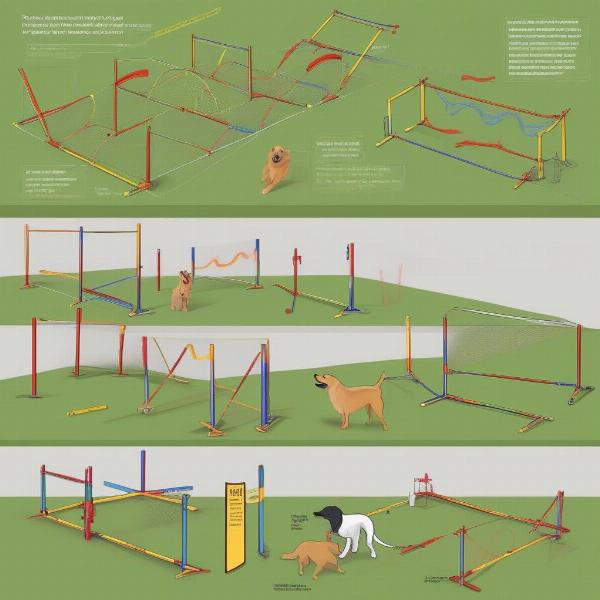Dog agility is a fantastic way to bond with your furry friend while providing them with much-needed physical and mental stimulation. A dog agility set provides the perfect platform for your dog to navigate obstacles, build confidence, and burn off excess energy. Whether you’re a seasoned competitor or just starting out, this comprehensive guide will equip you with everything you need to know about choosing, using, and maximizing the benefits of a dog agility set.
Choosing the Right Dog Agility Set
Selecting the perfect dog agility set can be overwhelming with so many options available. Consider your dog’s size, breed, age, and experience level when making your decision. For puppies or smaller breeds, a smaller, more basic set is ideal. Larger, more experienced dogs can benefit from a more challenging set with a variety of obstacles. Look for durable, weather-resistant materials to ensure your set lasts for years to come. Adjustable height options are also a plus, allowing you to tailor the difficulty to your dog’s progress.
Essential Components of a Dog Agility Set
A typical dog agility set includes a variety of obstacles designed to challenge your dog’s physical and mental abilities. Common components include:
- Weave poles: These poles encourage your dog to weave back and forth, improving coordination and body awareness.
- Tunnels: Tunnels offer a fun and exciting way for your dog to navigate enclosed spaces.
- Hurdles: Jumping hurdles builds strength and agility. Start with low hurdles and gradually increase the height as your dog progresses.
- A-frame: This ramp provides a challenging climb and descent, promoting balance and confidence.
- Pause table: This platform teaches your dog to pause and stay in a specific location, reinforcing obedience commands.
 Main components of a dog agility set
Main components of a dog agility set
Training Your Dog with an Agility Set
Introduce your dog to the agility set gradually and positively. Start with simple exercises and gradually increase the difficulty as your dog becomes more comfortable. Use positive reinforcement techniques like treats, praise, and toys to motivate your dog and make the experience enjoyable. Keep training sessions short and fun, especially in the beginning, to avoid overwhelming your dog.
Building Confidence and Trust
Building a strong bond of trust between you and your dog is essential for successful agility training. Encourage your dog with positive reinforcement and patience. Never force your dog to perform an exercise if they seem scared or hesitant. Focus on building their confidence and ensuring they enjoy the process.
Maintaining Your Dog Agility Set
Proper maintenance will extend the lifespan of your dog agility set. Regularly inspect the set for any damage or wear and tear. Tighten any loose bolts and replace any broken parts immediately. Clean the set regularly to prevent the buildup of dirt and debris. Store the set in a dry, protected area when not in use, especially during harsh weather conditions.
Conclusion
A dog agility set offers a rewarding and enriching experience for both you and your dog. By choosing the right set, implementing positive training techniques, and maintaining your equipment properly, you can help your dog reach their full potential while strengthening your bond. So, are you ready to embark on this exciting journey with your furry companion?
FAQ
- What age can I start agility training with my dog? While puppies can begin learning basic commands and exploring simple obstacles, formal agility training is generally recommended once they reach physical maturity, typically around 1-2 years of age.
- How often should I train my dog with an agility set? Start with short, frequent sessions of 10-15 minutes a few times a week, gradually increasing the duration and frequency as your dog progresses.
- What if my dog is afraid of the agility set? Start by introducing your dog to the set gradually and positively. Use treats and praise to encourage them to explore the equipment at their own pace. Never force your dog to interact with the set if they are scared.
- Can any breed of dog participate in agility training? Most breeds can enjoy agility training, however, some breeds are naturally more suited to it than others. Always consult with your veterinarian before starting any new exercise program with your dog.
- Where can I find dog agility competitions near me? Check with local dog training clubs, kennel clubs, and online resources for information on agility competitions in your area.
- What are the benefits of dog agility training? Agility training provides numerous benefits, including physical exercise, mental stimulation, improved obedience, and enhanced bonding between dog and owner.
- How much does a dog agility set cost? The cost of a dog agility set varies depending on the size, materials, and number of obstacles included.
Related Articles on ILM Dog
About ILM Dog
ILM Dog (https://ilmdog.com) is your comprehensive resource for expert dog care advice. We offer a wealth of information on dog breeds, health, training, nutrition, grooming, and much more. From puppy care to senior dog support, we cover all aspects of dog ownership. We believe that every dog deserves the best possible care, and we’re dedicated to providing dog owners with the knowledge and tools they need to provide just that. Contact us for all your dog-related queries via email at [email protected] or phone at +44 20-3965-8624.